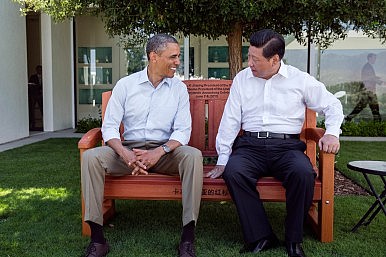(Photo Credit: Flickr/The White House)
(BGF) – Often, the current relationship between the U.S. and China is viewed as a Thucydidean Trap – essentially a struggle for power between two powers. In this article Shannon Tiezzi looks back at the U.S.-Chinese diplomacy and rhetoric and challenges the view that U.S.-Chinese relations is a Thucydidean Trap. Rather, Tiezzi contends that the current U.S.-Chinese relations are best conceptualized as a Prisoner’s Dilemma. Tiezzi argues that U.S. and Chinese leaders recognize the importance of collaboration and cooperation between the two powers. However, forewshadowing what Kai would later write in The Diplomat there is a deep sense of distrust between the U.S. and China. Thus, both the U.S. and China fear that the other will not follow through on its commitments to cooperate. As a result, neither side wants to be “left holding the bag when the other side inevitably turns hostile.” Therefore, it appears that a lack of trust between the U.S. and China is holding back U.S.-Chinese relations. An excerpt of the article is included below. Click here to read the full article or visit The Diplomat‘s website.
US-China Relations: Thucydidean Trap or Prisoner’s Dilemma?
By Shannon Tiezzi
U.S.-China relations are at a crossroads. China, now the number two economy in the world (and, depending on who you ask, projected to pass the U.S. as number one in 2016, 2020, 2028, or not at all), has a growing political and military clout commensurate with its economic prowess. Accordingly, China has a strategy for achieving a long-time goal: gaining control of its near seas, at least out to the so-called “first island chain.” The U.S., for its part, is loathe to cede its role as the dominant power in the Asia-Pacific, especially given its alliance relationships with many of China’s close neighbors (including South Korea, Japan, the Philippines, Thailand, and, unofficially of course, Taiwan).
But the issue of military or diplomatic dominance in the Asia-Pacific is merely a microcosm of the greater challenge: finding a balance of power between the U.S. and China that is acceptable to both nations. Many analysts have framed this dilemma as the “Thucydidean trap” that arises each time a rising power challenges as established one. To try and escape this historical trap (which has generally led to war), China’s leaders have proposed that China and the U.S. seek a “new type of great power relationship.” But what does this actually mean?
At one meeting between the U.S. and Chinese presidents, there were plenty of ideas on how the U.S. and China could work together. According to the American president, “China and the United States share a profound interest in a stable, prosperous, open Asia” so cooperation on the issue of North Korea’s nuclear program is a must. There’s also a need “to strengthen contacts between our militaries, including through a maritime agreement, to decrease the chances of miscalculation and increase America’s ties to a new generation of China’s military leaders.”
On a global front, “the United States and China share a strong interest in stopping the spread of weapons of mass destruction and other sophisticated weaponry in unstable regions and rogue states, notably Iran.” In addition, there is “the special responsibility our nations bear, as the top two emitters of greenhouse gases, to lead in finding a global solution to the global problem of climate change.”
And the Chinese president offers a broader assessment of what U.S.-China relations should look like: “It is imperative to handle China-U.S. relations and properly address our differences in accordance with the principles of mutual respect, noninterference in each other’s internal affairs, equality, and mutual benefit.”
The above are solid (if vague) proposals that offer a blueprint for moving U.S.-China relations forward. But hold on—those quotes weren’t from President Barack Obama and President Xi Jinping. The speakers were President Bill Clinton and President Jiang Zemin during a press conference in 1997. 17 years later, in 2014, these same issues are still being hashed over and trotted out as areas for improvement. Despite a mind-boggling proliferation in high-level meetings, Beijing and Washington have made little progress on the very issues they’ve been highlighting as areas of cooperation for nearly 20 years. Outside of a steady increase in bilateral trade, have U.S.-China relations really progressed since the 1990s? And if not, how can Beijing and Washington be expected to draw closer now, when the competition between the two is even greater?
Forget the “Thucydidean trap”—China and the U.S. are caught in the foreign policy version of the “prisoners’ dilemma.” Both understand, on a theoretical level, that the best outcome can only be reached via cooperation. But neither country trusts the other to cooperate (for reasons outlined in detail in a report by Brookings’ Kenneth Lieberthal and Peking University’s Wang Jisi). Both sides can “win” through cooperation, but since neither Beijing nor Washington really believes that will happen, they both seek not to be the country left holding the bag when the other side inevitably turns hostile.
Click here to continue reading.
